  What's New! Detailed Sitemap All images © by Roberto Piperno, owner of the domain. Write to romapip@quipo.it. Text edited by Rosamie Moore. Page added in October 2005. |

|
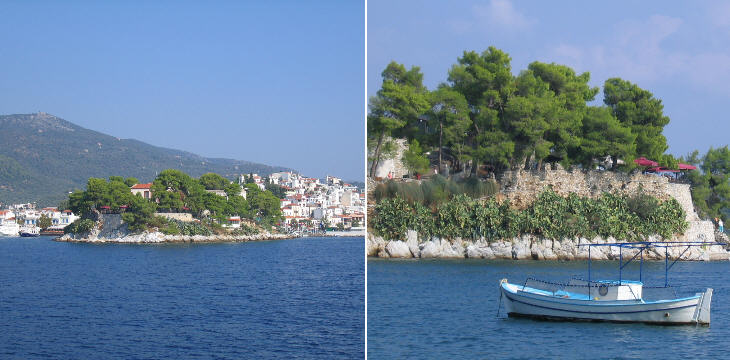 | ||
Today Skiathos is a very popular tourist resort mainly because of the sandy beaches of its southern coast. The eight miles or so between the town of Skiathos and the beach of Koukounaries swarm with tourists and an incredible number of pubs, discos, fast foods, even Indian restaurants give to this part of the island the same picturesque Greek appeal of London's Earls' Court (i.e. none).
The town of Skiathos is relatively modern because until 1821 the inhabitants of the island lived on a fortified promontory on the northern coast: they resettled on a bay which was the natural harbour of the island and which was protected by a small medieval fortification, most likely built by the Ghisi in the XIIIth century. As other similar small fortresses protecting a harbour it is called bourtzi (see that of Napoli di Romania).
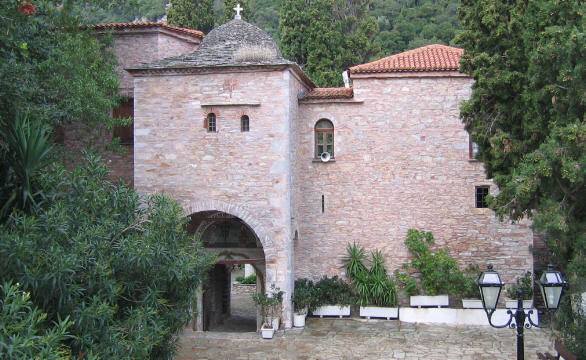 | ||
The road leading to the old capital is in very poor condition: the paved road ends at Evangelistria Monastery, a fortified site with a commanding view over both the southern and the northern coasts of the island.
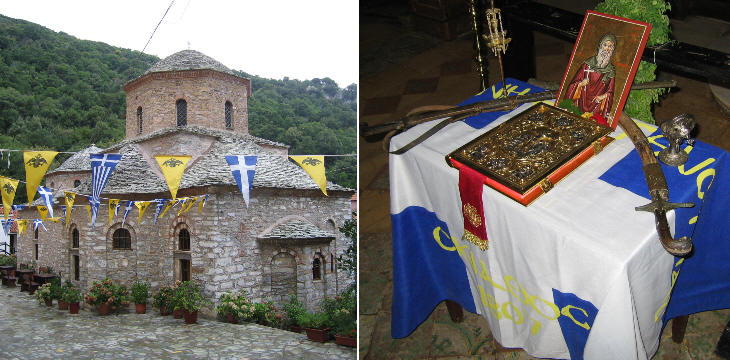 | ||
The church of the monastery retains on its main altar (decorated by a Bible between two scimitars, a very modern association of symbols) what is considered the first flag of Modern Greece, a white cross on a blue background. It was first raised in 1807 during a failed revolt against the Turks. The Greek flag was subsequently modified following the pattern of the American flag with the addition of nine white and blue stripes: a reference to the first nine syllables "Se gnoriso apo tin kopsi (We knew thee of old)" of the Greek national anthem "Hymn to Eleftheria (Freedom)", written by Dionysios Solomos, a poet from Zante.
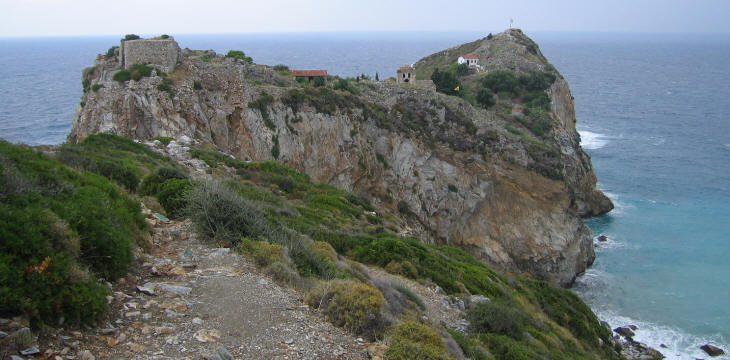 | ||
The old town of Schiatto was located on an isolated headlong. High cliffs protected the site which could only be reached by land.
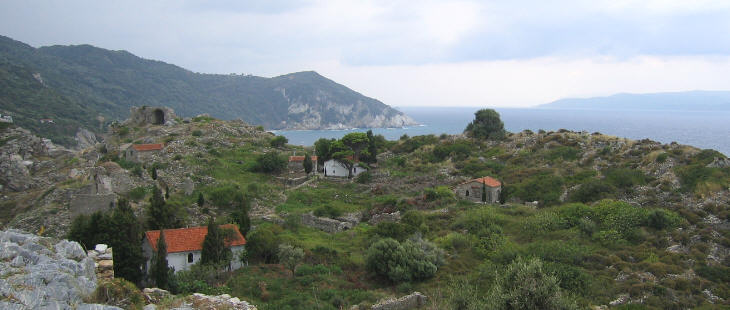 | ||
Only three small churches and a former mosque are not in ruins. Scattered stones and low walls give an indication of the old town's winding streets. The site allowed control of the channel between the island and the mainland. A lone cannon (which you can see in the image used as a background for this page) marks the site of a small fortress on the headlong highest point.
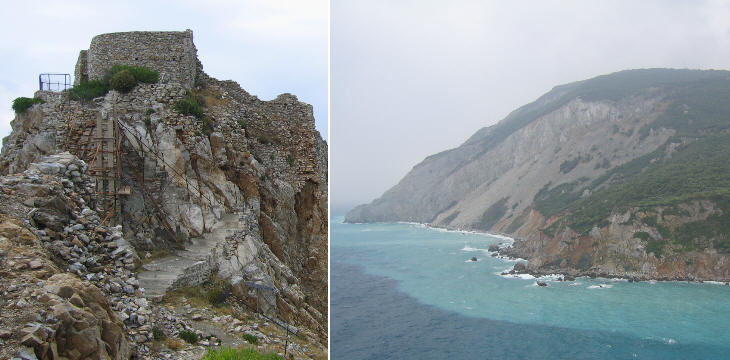 | ||
A drawbridge was the only access to the town: it was protected by two towers. So much of the coast around modern Skiathos is pleasant and welcoming, such a contrast to the coast near old Schiatto which is desolate and unfriendly. The fortress was considered impregnable. In 1660 however, the Venetian admiral Francesco Morosini, in charge of the defence of Candia, at the time besieged by the Turks, launched an offensive against the Aegean Islands which refused to financially help the Venetians, and because Schiatto refused to pay, he attacked and seized the fortress.
Introductory page on the Venetian Fortresses
Pages of this section:
On the Ionian Islands: Corfų (Kerkyra) Paxo (Paxi) Santa Maura (Lefkadas) Cefalonia (Kephallonia) Asso (Assos) Itaca (Ithaki) Zante (Zachintos) Cerigo (Kythera)
On the mainland: Butrinto (Butrint) Parga Preveza and Azio (Aktion) Vonizza (Vonitsa) Lepanto (Nafpaktos) Atene (Athens)
On Morea: Castel di Morea (Rio), Castel di Rumelia (Antirio) and Patrasso (Patra) Castel Tornese (Hlemoutsi) and Glarenza Navarino (Pilo) and Calamata Modon (Methoni) Corone (Koroni) Braccio di Maina, Zarnata, Passavā and Chielefā Mistrā Corinto (Korinthos) Argo (Argos) Napoli di Romania (Nafplio) Malvasia (Monemvassia)
On the Aegean Sea: Negroponte (Chalki) Castelrosso (Karistos) Oreo Lemno (Limnos) Schiatto (Skiathos) Scopello (Skopelos) Alonisso Schiro (Skyros) Andro (Andros) Tino (Tinos) Micono (Mykonos) Siro (Syros) Egina (Aegina) Spezzia (Spetse) Paris (Paros) Antiparis (Andiparos) Nasso (Naxos) Serifo (Serifos) Sifno (Syphnos) Milo (Milos) Argentiera (Kimolos) Santorino (Thira) Folegandro (Folegandros) Stampalia (Astipalea) Candia (Kriti)
You may refresh your knowledge of the history of Venice in the Levant by reading an abstract from the History of Venice by Thomas Salmon, published in 1754. The Italian text is accompanied by an English summary.
Clickable Map of the Ionian and Aegean Seas with links to the Venetian fortresses and to other locations (opens in a separate window)
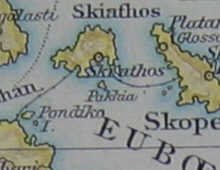 Schiatto (Skiathos)
Schiatto (Skiathos)